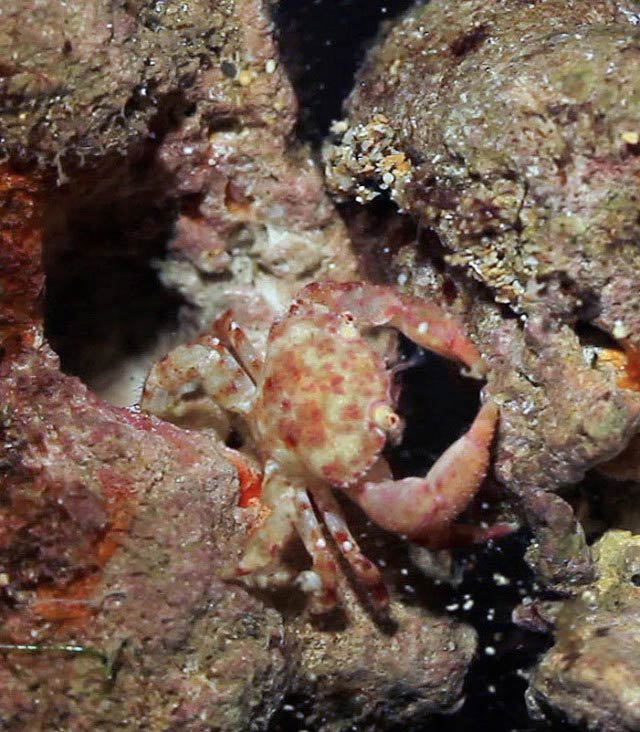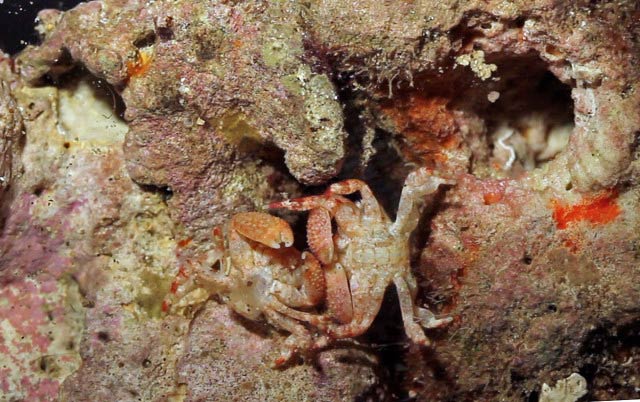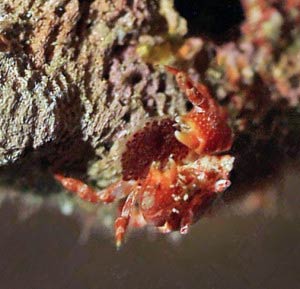As promised in my last article, there is more Atlas crab behavior to share. To recap, I had collected a few of these dead coral pieces (which I will sometimes refer to here as rocks) with their resident crabs and kept them in an aquarium for a couple days before putting them back in their neighborhood. Because they are not in ID books, I wanted to try and find out what species they were, and to learn what they are doing under there!

Even though the crabs were in a foreign environment (a small aquarium) they quickly started moving their dead coral homes around. Next, they all began picking at whatever they could find on their or their neighbor’s rock. Using their big claws (chelipeds) they picked at the rock and put whatever they were getting in their mouth.
One other cool thing that the video showed was the amount of current that the crab generates to move water across its gills. As divers we don’t even notice this underwater when looking at a crab. We see all the appendages moving up by its face, but we don’t see the current. Because the bottom of the tank was clean, the current was very apparent when the few pieces of debris by the crab’s mouth were blown out of the way. Crabs create this current to force water over their gills so they can “breathe.” Normal water movement is not enough.
(In this photo an Atlas crab is picking something edible off of the rock. You can see some of the debris that is flying around due to the current the crab is producing with his head appendages. You can see video of the crab feeding here:
By chance I had collected one rock occupied by a male and two others by females. That made for some interesting interactions. When put in the same tank they probably began communicating chemically right away. Then the male began performing his courtship duties which included intermittent vibrating of his large claws and some of his other legs. The vibrating could have been sending a vibrational signal to the female, and, once they were in contact, a tactile signal as well. They both flapped their abdomens and then slowly they inched into their mating position which is basically belly to belly – with 20 major appendages to keep out of the way in the process. It was kind of excruciatingly too intimate to watch, but I posted the video here. After about fifteen seconds they suddenly separated and bolted to their separate holes. In the photo below the male crab on the right is just beginning to reach for the female on the left. It took them another whole minute to even get into position.


The other female crab that I had brought in was carrying a batch of well-developed cranberry colored eggs, and she could not come out of her hole fast enough to begin aerating them. The developing embryos inside the egg capsules require oxygen which diffuses through the egg capsule membrane, so she must keep water moving across them or the embryos will suffocate.
The female that I watched spent most of her time vigorously flapping her abdomen open and closed, and the eggs that were attached to it were agitated along with it. She also periodically moved her claws and legs through the eggs to clean them. All the while she was creating a current in the water by moving her head appendages which helped to aerate the eggs too.
(In this photo from the video, the female Atlas crab’s abdomen is fully extended as she opens and closes it to move water around the eggs and to keep them aerated).
Also while I was videoing, a juvenile Atlas crab emerged from one of the rocks “operated by” an adult. It is likely that juveniles live in coral pieces that are carried by the adults. Do they leave and find their own piece of rubble once they are mature, or do some wait in line to take over the existing coral if the resident crab is an aging individual? Do they remain in the same rock their whole lives, enlarging the hole as they grow or do they try on different unoccupied rocks or trade/fight for already occupied rocks?
And, what do they eat? Do they mostly scavenge underneath their coral homes and supplement their diet with what grows on their homes? Do they “farm” the algae and organisms growing on their home coral by picking off undesirable species and allowing desirable species to grow?
What a world of their own these little crabs have underneath their dead coral pieces… so many unknown details of their lives.
